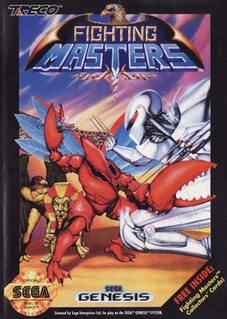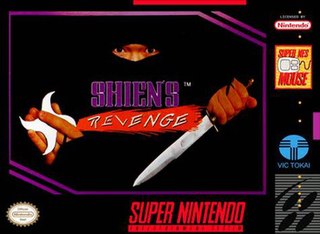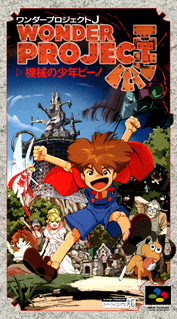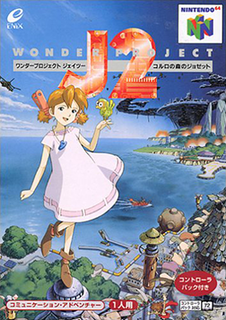 W
WCosmic Carnage is a 1994 fighting video game developed by Almanic Corporation, in conjunction with ALU, and published by Sega exclusively for the 32X add-on. Set in a uncharted star system, the game follows eight fighters from two factions in a struggle for survival. Its gameplay consists of one-on-one fights, with a main six-button configuration, featuring special moves and finisher techniques, as well as two playable modes. The title garnered mostly negative reception from critics since its release.
 W
WE.V.O.: Search for Eden is a side-scrolling action video game developed by Almanic Corporation and published by Enix for the Super Nintendo Entertainment System. Released in 1992 for Japanese audiences, the game was later translated and released in North America in 1993. Combining traditional platforming mechanics with experience and leveling mechanics originating from role playing games, E.V.O.: Search for Eden involves the player navigating a creature through a number of side-scrolling levels while undergoing bodily evolution to cope with ever-changing environments. It is heavily based on Almanic's original title, 46 Okunen Monogatari ~The Shinka Ron~, released exclusively in Japan for the PC-9801 home computer in 1990.
 W
WFighting Masters is a 1991 fighting video game developed by Almanic Corporation, in conjunction with Aicom and ALU, and published for the Sega Genesis in Japan and later in North America by Treco. In the game, players assume the role of a hero to fight against an assortment of opponents on a apocalyptic setting to face against an entity known as Lord Valgasu. Co-directed by Hajime Kusano and Ramō Kobayashi, the title was created by some of the same team that would later work on various projects at Almanic such as E.V.O.: Search for Eden. It was met with mixed reception from critics since its release.
 W
WNanatsu Kaze no Shima Monogatari is a 1997 graphic adventure video game developed by Givro Corporation and published by Enix for the Sega Saturn. The last game to be created by Givro prior to their dissolution in 1998, the title takes place on a mysterious island, as players assume the role of a dragon named Gaūpu to meet various creatures inhabiting the location while harnessing seven legendary winds to overcome obstacles. It received positive reception from critics and reviewers alike, with high praise given towards its hand-drawn visuals.
 W
WShien's Revenge is a 1994 rail shooter video game developed by Almanic Corporation and originally published by Dynamic Planning for the Super Nintendo Entertainment System in Japan and later in North America by Vic Tokai. In the game, players assume the role of the titular ninja to fight against monsters coming from a time portal in order to face against an entity known as Undertaker and rescue his companion Aska. Co-designed by Takashi Shichijo and mangaka Go Nagai, the title was created by most of the same team that worked on previous projects at Almanic such as E.V.O.: Search for Eden. It was met with mixed reception from critics since its release.
 W
WShin Nekketsu Kōha: Kunio-tachi no Banka is a belt-scrolling action game developed by Almanic and released by Technos Japan Corp. exclusively in Japan for the Super Famicom in 1994. It was the fourth game in the Kunio-kun series released for the Super Famicom.
 W
WSuper Mad Champ is a vehicular combat racing video game developed by Givro Corporation and published by Tsukuda Original in Japan exclusively for the Super Famicom on 4 March, 1995. Centered around a series of road races throughout various locations, the player must win to advance in higher-difficulty races while using attacks to hinder other racers. Directed by Nanako Geya, the game was created by most of the same team that worked on previous projects at Givro such as Shin Nekketsu Kōha: Kunio-tachi no Banka, initially intended to be published by Technōs Japan under a different title before release.
 W
WWonder Project J is a 1994 life simulation video game developed by Almanic Corporation and published by Enix for the Super Famicom. In the game, players take care of a boy Gijin (robot) created by Dr. Geppetto named Pino. Directed by Takashi Yoneda, the title was created by most of the same personnel that worked on previous projects at Almanic such as E.V.O.: Search for Eden. It was met with positive reception from critics and sold over 1.3 million copies in Japan, making it one of the best-selling Super Famicom games. A sequel, Wonder Project J2, was released in 1996 for the Nintendo 64.
 W
WWonder Project J2 is a 1996 life simulation video game developed by Givro Corporation and originally published by Enix for the Nintendo 64. It is the sequel to Wonder Project J, which was released earlier in 1994 for the Super Famicom.